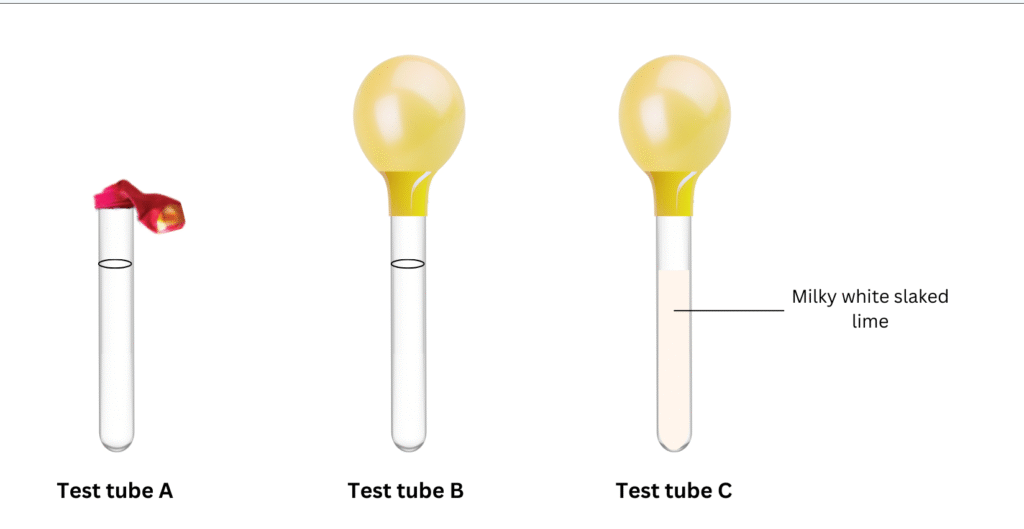4. Project : Requirements – 2 test tubes, marker pen, sugar, yeast powder, 2 balloons and lime water. Take two test tubes and mark them A and B. Clamp these tubes in a stand and fill them with water leaving some space at the top. Put two spoonfuls of sugar in each of the test tubes. Add a spoonful of yeast in test tube B. Inflate the two balloons incompletely. Now tie the balloons on the mouths of each test tube. Keep them in a warm place, away from sunlight. Watch the setup every day for next 3-4 days. Record your observations and think of an explanation. Now take another test tube filled 1/4 with lime water. Remove the balloon from test tube B in such a manner that gas inside the balloon does not escape. Fit the balloon on the test tube and shake well. Observe and explain.
Answer: The above activity can be carried out as follows:
Aim: To observe what happens to each balloon initially and also observe how the gas inside balloon B reacts with lime water and then conclude.
Materials Required: 3 test tubes, stand, marker pen, sugar, yeast powder, 2 balloons and lime water.
Procedure:
(i) Clamp test tubes A and B to the stand and fill them with water leaving some space at the top.
(ii) Add two spoonfuls of sugar in each of the test tubes and also a spoonful of yeast in test tube B.
(iii) Partially inflate the two balloons incompletely and then tie the balloons on the mouths of each test tube.
(iv) Place the stand containing the test tubes in a warm place away from the sunlight, watch the setup every day for next 3-4 days and make the necessary conclusions.
(v) Now fill the third test tube C 1/4 with lime water. Remove the balloon from test tube B such that the gas inside the balloon does not escape, fit the balloon on the test tube C and shake well. Observe what happens and make the necessary conclusions.
Observations:
We observe that:
- Initially the balloon attached to test tube B inflates and the balloon attached to test tube A does not inflate.
- When the inflated balloon is then attached to test tube C filled 1/4 with lime water and the contraption is shaken, the lime water turns milky.

Conclusions:
We conclude that:
- Since the lime water in test tube C turns milky white in contact with the gas, we conclude that the gas is carbon dioxide.
- Therefore, we conclude that in test tube B yeast converts sugar into carbon dioxide and alcohol by the process of fermentation. The production of carbon dioxide gas causes the balloon to inflate.
“4. Project : Requirements – 2 test tubes, marker pen, sugar, yeast powder, 2 balloons and lime water. Take two test tubes and mark them A and B. Clamp these tubes in a stand and fill them with water leaving some space at the top. Put two spoonfuls of sugar in each of the test tubes. Add a spoonful of yeast in test tube B. Inflate the two balloons incompletely. Now tie the balloons on the mouths of each test tube. Keep them in a warm place, away from sunlight. Watch the setup every day for next 3-4 days. Record your observations and think of an explanation. Now take another test tube filled 1/4 with lime water. Remove the balloon from test tube B in such a manner that gas inside the balloon does not escape. Fit the balloon on the test tube and shake well. Observe and explain.” – Solved.
Related Links:
Solution to Extended Learning Problem 1
Solution to Extended Learning Problem 2
Solution to Extended Learning Problem 3
Solution to Activity 2.1
Solution to Activity 2.2
Solution to Activity 2.3
Solution to Activity 2.4
Solutions to Chapter 2 Microorganisms: Friend and Foe


